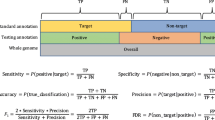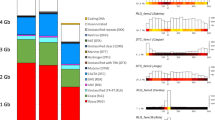Abstract
Triticeae species (including wheat, barley and rye) have huge and complex genomes due to polyploidization and a high content of transposable elements (TEs). TEs are known to play a major role in the structure and evolutionary dynamics of Triticeae genomes. During the last 5 years, substantial stretches of contiguous genomic sequence from various species of Triticeae have been generated, making it necessary to update and standardize TE annotations and nomenclature. In this study we propose standard procedures for these tasks, based on structure, nucleic acid and protein sequence homologies. We report statistical analyses of TE composition and distribution in large blocks of genomic sequences from wheat and barley. Altogether, 3.8 Mb of wheat sequence available in the databases was analyzed or re-analyzed, and compared with 1.3 Mb of re-annotated genomic sequences from barley. The wheat sequences were relatively gene-rich (one gene per 23.9 kb), although wheat gene-derived sequences represented only 7.8% (159 elements) of the total, while the remainder mainly comprised coding sequences found in TEs (54.7%, 751 elements). Class I elements [mainly long terminal repeat (LTR) retrotransposons] accounted for the major proportion of TEs, in terms of sequence length as well as element number (83.6% and 498, respectively). In addition, we show that the gene-rich sequences of wheat genome A seem to have a higher TE content than those of genomes B and D, or of barley gene-rich sequences. Moreover, among the various TE groups, MITEs were most often associated with genes: 43.1% of MITEs fell into this category. Finally, the TRIM and copia elements were shown to be the most active TEs in the wheat genome. The implications of these results for the evolution of diploid and polyploid wheat species are discussed.




Similar content being viewed by others
References
Altschul SF, Madden TL, Schäffer AA, Zhang J, Zhang Z, Miller W, Lipman DJ (1997) Gapped BLAST and PSI-BLAST: a new generation of protein database search programs. Nucleic Acids Res 25:3389–3402
Anderson OD, Rausch C, Moullet O, Lagudah ES (2003) The wheat D-genome HMW-glutenin locus: BAC sequencing, gene distribution, and retrotransposon clusters. Funct Integr Genomics 3:56–68
Bendich AJ, McCarthy BJ (1970) DNA comparisons among barley, oats, rye, and wheat. Genetics 65:545–565
Bennett MD, Leitch IJ (1995) Nuclear DNA amounts in angiosperms. Ann Bot 76:113–176
Bennetzen JL (2000) Transposable element contributions to plant gene and genome evolution. Plant Mol Biol 42:251–269
Bennetzen JL, Ma J, Devos KM (2005) Mechanisms of recent genome size variation in flowering plants. Ann Bot 95:127–132
Benson G (1999) Tandem repeats finder: a program to analyze DNA sequences. Nucleic Acids Res 27:573–580
Blanco E, Parra G, Guigo R (2002) Using GeneID to identify genes. Current protocols in bioinformatics. Wiley, New York
Brooks SA, Huang L, Gill BS, Fellers JP (2002) Analysis of 106 kb of contiguous DNA sequence from the D genome of wheat reveals high gene density and a complex arrangement of genes related to disease resistance. Genome 45:963–972
Bureau TE, Wessler SR (1994a) Mobile inverted-repeat elements of the Tourist family are associated with the genes of many cereal grasses. Proc Natl Acad Sci USA 91:1411–1415
Bureau TE, Wessler SR (1994b) Stowaway: a new family of inverted repeat elements associated with the genes of both monocotyledonous and dicotyledonous plants. Plant Cell 6:907–916
Chantret N et al (2005) Molecular basis of evolutionary events that shaped the Hardness locus in diploid and polyploid wheat species (Triticum and Aegilops). Plant Cell 17:1033–1045
Chantret N, Cenci A, Sabot F, Anderson O, Dubcovsky J (2004) Sequencing of the Triticum monococcum Hardness locus reveals good microcolinearity with rice. Mol Genet Genomics 271:377–386
Devos KM, Brown JKM, Bennetzen JL (2002) Genome size reduction through illegitimate recombination counteracts genome expansion in Arabidopsis. Genome Res 12:1075–1079
Dubcovsky J, Ramakrishna W, SanMiguel PJ, Busso CS, Yan L, Shiloff BA, Bennetzen JL (2001) Comparative sequence analysis of colinear barley and rice bacterial artificial chromosomes. Plant Physiol 125:1342–1353
Feschotte C, Jiang N, Wessler SR (2002) Plant transposable elements: where genetics meets genomics. Nat Rev Genet 3:329–341
Feuillet C, Keller B (1999) High gene density is conserved at syntenic loci of small and large grass genomes. Proc Natl Acad Sci USA 96:8265–8270
Feuillet C, Penger A, Gellner K, Mast A, Keller B (2001) Molecular evolution of receptor-like kinase genes in hexaploid wheat. Independent evolution of orthologs after polyploidization and mechanisms of local rearrangements at paralogous loci. Plant Physiol 125:1304–1313
Flavell RB, Rimpau J, Smith DB (1977) Repeated sequence DNA relationship in four cereals genomes. Chromosoma 63:205–222
Gu YQ, Coleman-Derr DA, Kong X, Anderson OD (2004) Rapid genome evolution revealed by comparative analysis of orthologous regions from four Triticeae genomes. Plant Physiol 135:459–470
Hu J, Reddy VS, Wessler SR (2000) The rice R gene family: two distinct subfamilies containing several miniature inverted-repeat transposable elements. Plant Mol Biol 42:667–678
Huang S, Sirikhachornkit A, Faris JD, Su X, Gill BS, Haselkorn R, Gornicki P (2002) Phylogenetic analysis of the acetyl-CoA carboxylase and 3-phosphoglycerate kinase loci in wheat and other grasses. Plant Mol Biol 48:805–820
Huang L, Brooks SA, Wanlong L, Fellers JP, Trick HN, Gill BS (2003) Map-based cloning of leaf rust resistance gene Lr21 from the large and polyploid genome of bread wheat. Genetics 164:655–664
Iwamoto M, Higo K (2003) Tourist C transposable elements are closely associated with genes expressed in flowers in rice (Oryza sativa). Mol Genet Genomics 268:771–778
Jiang N, Wessler SR (2001) Insertion preference of maize and rice miniature inverted repeat transposable elements as revealed by the analysis of nested element. Plant Cell 13:2553–2564
Juretic N, Bureau TE, Bruskiewich RM (2004) Transposable elements annotation of the rice genome. Bioinformatics 20:155–160
Jurka J (1997) Sequence patterns indicate an enzymatic involvement in integration of mammalian retroposons. Proc Natl Acad Sci USA 94:1872–1877
Jurka J (2000) RepBase update: a database and an electronic journal of repetitive elements. Trends Genet 16:418–420
Kalendar R, Vicient CM, Peleg O, Anamthawat-Jonsson K, Bolshoy A, Schulman AH (2004) LArge retrotransposon derivatives: abundant, conserved but non-autonomous retroelements of barley and related genomes. Genetics 166:1437–1450
Kapitonov VV, Jurka J (2001) Rolling-circle transposons in eukaryotes. Proc Natl Acad Sci USA 98:8714–8719
Keller B, Feuillet C (2000) Colinearity and gene density in grass genomes. Trends Plant Sci 5:246–251
Kong X-Y, Gu YQ, You FM, Dubcovsky J, Anderson OD (2004) Dynamics of the evolution of orthologous and paralogous portions of a complex locus region in two genomes of allopolyploid wheat. Plant Mol Biol 54:55–69
Kumar A, Bennetzen JL (1999) Plant retrotransposons. Annu Rev Genet 33:479–532
Lal SK, Giroux MJ, Brendel V, Vallejos CE, Hannah LC (2003) The maize genome contains a Helitron insertion. Plant Cell 15:381–391
Levy AA, Feldman M (2002) The impact of polyploidy on grass genome evolution. Plant Physiol 130:1587–1593
Li W, Zhang P, Fellers JP, Friebe B, Gill BS (2004) Sequence composition, organization and evolution of the core Triticeae genome. Plant J 40:500–511
Lijavetzky D, Muzzi G, Wicker T, Keller B, Wing R, Dubcovsky J (1999) Construction and characterization of a bacterial artificial chromosome (BAC) library for the A genome of wheat. Genome 42:1176–1182
Lukashin AV, Borodovsky M (1998) GeneMark.hmm: new solutions for gene finding. Nucleic Acids Res 26:1107–1115
Ma J, Devos KM, Bennetzen JL (2004) Analyses of LTR-retrotransposon structures reveal recent and rapid genomic DNA loss in rice. Genome Res 14:860–869
Mao L, Wood TC, Yu Y, Budiman MA, Tomkins J, Woo S-S, Sasinwski M, Presting G, Frisch D, Goff S, Dean RA, Wing RA (2000) Rice transposable elements: a survey of 73,000 sequence-tagged-connectors. Genome Res 10:982–990
McCarthy EM, McDonald JF (2003) LTR_STRUC: a novel search and identification program for LTR retrotransposons. Bioinformatics 19:362–367
Messing J, Bharti AK, Karlowski WM, Gundlach H, Kim HR, Yu Y, Wei F, Fuks G, Soderlund CA, Mayer KFX, Wing RA (2004) Sequence composition and genome organization of maize. Proc Natl Acad Sci USA 101:14349–14354
Meyers BC, Tingey SV, Morgante M (2001) Abundance, distribution, and transcriptional activity of repetitive elements in the maize genome. Genome Res 11:1660–1676
Rahman S, Abrahams S, Abbot D, Mukai Y, Samuel M, Morell M, Appels R (1997) A complex arrangement of genes at a starch branching enzyme I locus in the D-genome donor of wheat. Genome 40:465–474
Rutherford K, Parkhill J, Crook JHT, Rice P, Rajandream M-A, Barrell B (2000) ARTEMIS: sequence visualisation and annotation. Bioinformatics 16:944–945
Sabot F, Simon D, Bernard M (2004) Plant transposable elements, with an emphasis on grass species. Euphytica 139:227–247
Salamini F, Ozkan H, Brandolini A, Schafer-Pregl R, Martin W (2002) Genetics and geography of wild cereal domestication in the near east. Nat Rev Genet 3:429–441
Sandhu D, Gill KS (2002) Gene-containing regions of wheat and the other grass genomes. Plant Physiol 128:803–8011
SanMiguel P, Tikhonov A, Jin Y-K, Motchoulskaia N, Zakharov D, Melake-Berhan A, Springer PS, Edwards KJ, Lee M, Avramova Z, Bennetzen JL (1996) Nested retrotransposons in the intergenic regions of the maize genome. Science 274:765–768
SanMiguel P, Ramakrishna W, Bennetzen JL, Busso C, Dubcovsky J (2002) Transposable elements, genes and recombination in a 215-kb contig from wheat chromosome 5Am. Funct Integr Genom 2:70–80
Sonnhammer ELL, Durbin R (1995) A dot-matrix program with dynamic threshold control suited for genomic DNA and protein sequence analysis. Gene 167:1–10
Vitte C, Panaud O (2003) Formation of solo-LTRs through unequal homologous recombination counterbalances amplifications of LTR retrotransposons. Mol Biol Evol 20:528–540
Wendel JF (2000) Genome evolution in polyploids. Plant Mol Biol 42:225–249
Wicker T, Stein N, Albar L, Feuillet C, Schlagenhauf E, Keller B (2001) Analysis of a 211-kb sequence in diploid wheat (Triticum monococcum L.) reveals multiple mechanisms of genome evolution. Plant J 26:307–316
Wicker T, Matthews DE, Keller B (2002) TREP: a database for Triticeae REPetitive elements. Trends Plant Sci 7:561–562
Wicker T, Yahiaoui N, Guyot R, Schlagenhauf E, Liu Z-D, Dubcovsky J, Keller B (2003a) Rapid genome divergence at orthologous low molecular weight glutenin loci of the A and Am genomes of wheat. Plant Cell 15:1186–1197
Wicker T, Guyot R, Yahiaoui N, Keller B (2003b) CACTA transposons in Triticeae. A diverse family of high-copy repetitive elements. Plant Physiol 132:52–63
Witte C-P, Le QH, Bureau TE, Kumar A (2001) Terminal-repeat retrotransposons in miniature (TRIM) are involved in restructuring plant genomes. Proc Natl Acad Sci USA 98:13778–13783
Wright DA, Voytas DF (2002) Athila4 of Arabidopsis and Calypso of soybean define a lineage of endogenous plant retroviruses. Genome Res 12:122–131
Yan L, Echenique V, Busso C, SanMiguel P, Ramakrishna W, Bennetzen JL, Harrington S, Dubcovsky J (2002) Cereal genes similar to Snf2 define a new subfamily that includes human and mouse genes. Mol Genet Genomics 268:488–499
Yan L, Loukoianov A, Tranquilli G, Helguera M, Fahima T, Dubcovsky J (2003) Positional cloning of the wheat vernalization gene VRN1. Proc Natl Acad Sci USA 100:6263–6268
Yan L, Loukoianov A, Blechl A, Tranquilli G, Ramakrishna W, SanMiguel P, Bennetzen JL, Echenique V, Dubcovsky J (2004) The wheat VRN2 gene is a flowering repressor down-regulated by vernalization. Science 303:1640–1644
Acknowledgements
The authors thank Catherine Feuillet and Beat Keller for their corrections and their “bloody cuts”, Alan Schulman for his help on the activity index and his corrections, Jorge Dubcovsky, the reviewers and the editor for their constructive observations and Bikram Gill, John Fellers, Dave Matthews and all the corresponding authors of the previous articles on large genomic sequences for their help.
Author information
Authors and Affiliations
Corresponding author
Additional information
Communicated by R. Hagemann
Electronic supplementary material
Rights and permissions
About this article
Cite this article
Sabot, F., Guyot, R., Wicker, T. et al. Updating of transposable element annotations from large wheat genomic sequences reveals diverse activities and gene associations. Mol Genet Genomics 274, 119–130 (2005). https://doi.org/10.1007/s00438-005-0012-9
Received:
Accepted:
Published:
Issue Date:
DOI: https://doi.org/10.1007/s00438-005-0012-9




